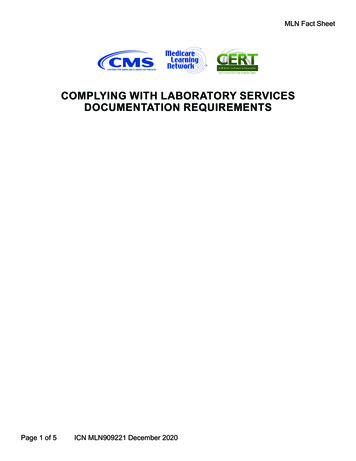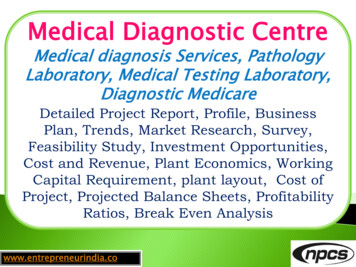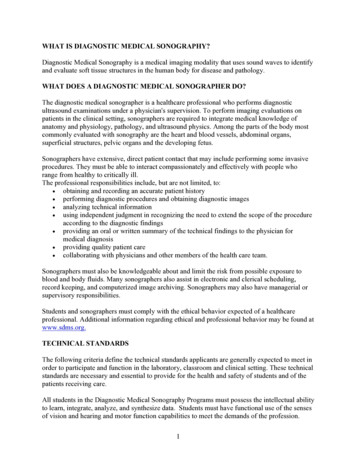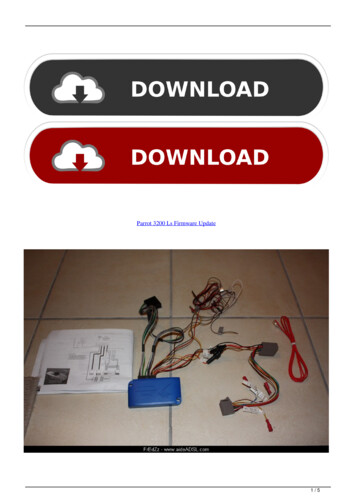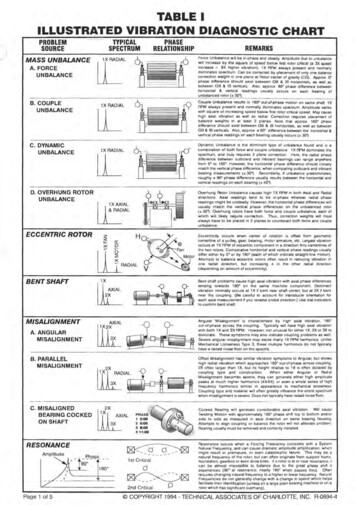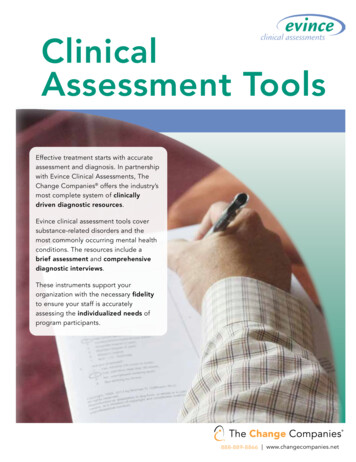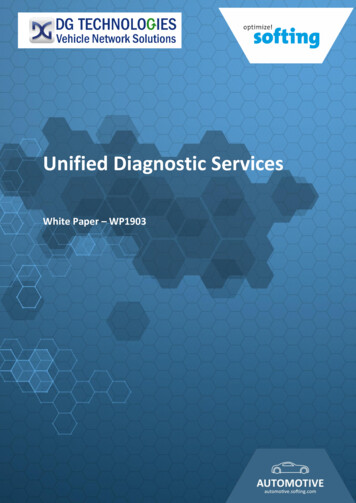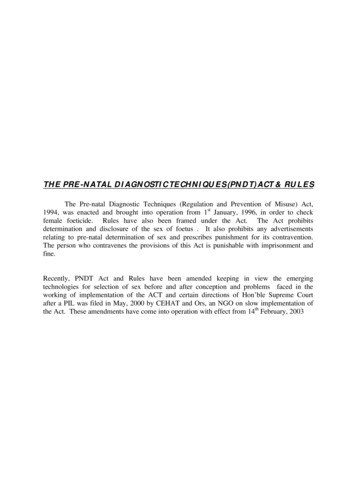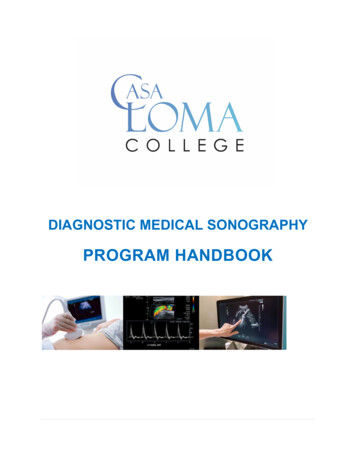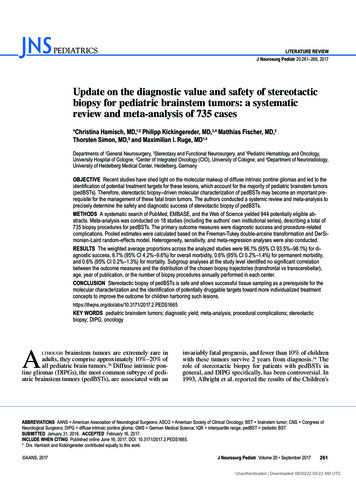
Transcription
LITERATURE REVIEWJ Neurosurg Pediatr 20:261–268, 2017Update on the diagnostic value and safety of stereotacticbiopsy for pediatric brainstem tumors: a systematicreview and meta-analysis of 735 cases*Christina Hamisch, MD,1,2 Philipp Kickingereder, MD,3,4 Matthias Fischer, MD,5Thorsten Simon, MD,5 and Maximilian I. Ruge, MD1,4Departments of 1General Neurosurgery, 3Stereotaxy and Functional Neurosurgery, and 5Pediatric Hematology and Oncology,University Hospital of Cologne; 2Center of Integrated Oncology (CIO), University of Cologne; and 4Department of Neuroradiology,University of Heidelberg Medical Center, Heidelberg, GermanyOBJECTIVE Recent studies have shed light on the molecular makeup of diffuse intrinsic pontine gliomas and led to theidentification of potential treatment targets for these lesions, which account for the majority of pediatric brainstem tumors(pedBSTs). Therefore, stereotactic biopsy–driven molecular characterization of pedBSTs may become an important prerequisite for the management of these fatal brain tumors. The authors conducted a systemic review and meta-analysis toprecisely determine the safety and diagnostic success of stereotactic biopsy of pedBSTs.METHODS A systematic search of PubMed, EMBASE, and the Web of Science yielded 944 potentially eligible abstracts. Meta-analysis was conducted on 18 studies (including the authors’ own institutional series), describing a total of735 biopsy procedures for pedBSTs. The primary outcome measures were diagnostic success and procedure-relatedcomplications. Pooled estimates were calculated based on the Freeman-Tukey double-arcsine transformation and DerSimonian-Laird random-effects model. Heterogeneity, sensitivity, and meta-regression analyses were also conducted.RESULTS The weighted average proportions across the analyzed studies were 96.1% (95% CI 93.5%–98.1%) for diagnostic success, 6.7% (95% CI 4.2%–9.6%) for overall morbidity, 0.6% (95% CI 0.2%–1.4%) for permanent morbidity,and 0.6% (95% CI 0.2%–1.3%) for mortality. Subgroup analyses at the study level identified no significant correlationbetween the outcome measures and the distribution of the chosen biopsy trajectories (transfrontal vs transcerebellar),age, year of publication, or the number of biopsy procedures annually performed in each center.CONCLUSION Stereotactic biopsy of pedBSTs is safe and allows successful tissue sampling as a prerequisite for themolecular characterization and the identification of potentially druggable targets toward more individualized treatmentconcepts to improve the outcome for children harboring such PEDS1665KEY WORDS pediatric brainstem tumors; diagnostic yield; meta-analysis; procedural complications; stereotacticbiopsy; DIPG; oncologyAlthough brainstem tumors are extremely rare inadults, they comprise approximately 10%–20% ofall pediatric brain tumors.26 Diffuse intrinsic pontine gliomas (DIPGs), the most common subtype of pediatric brainstem tumors (pedBSTs), are associated with aninvariably fatal prognosis, and fewer than 10% of childrenwith these tumors survive 2 years from diagnosis.34 Therole of stereotactic biopsy for patients with pedBSTs ingeneral, and DIPG specifically, has been controversial. In1993, Albright et al. reported the results of the Children’sABBREVIATIONS AANS American Association of Neurological Surgeons; ASCO American Society of Clinical Oncology; BST brainstem tumor; CNS Congress ofNeurological Surgeons; DIPG diffuse intrinsic pontine glioma; GMS German Medical Science; IQR interquartile range; pedBST pediatric BST.SUBMITTED January 31, 2016. ACCEPTED February 16, 2017.INCLUDE WHEN CITING Published online June 16, 2017; DOI: 10.3171/2017.2.PEDS1665.* Drs. Hamisch and Kickingereder contributed equally to this work. AANS, 2017J Neurosurg Pediatr Volume 20 September 2017261Unauthenticated Downloaded 08/30/22 09:23 AM UTC
C. Hamisch et al.Cancer Group DIPG study and concluded that MRI wasadequate in making the diagnosis, since tissue samplingdid not alter the treatment or impact outcome.2 Based onthis conclusion and the presumed risk profile of stereotactic biopsy procedures in the brainstem, referring tostudies reporting transient or permanent morbidity ratesof up to 28% and 9%, respectively,5,7 and mortality ratesof up to 4%,31 tissue sampling has been rarely performed.Thus, very little information on the molecular biology ofDIPG has been available until very recently, when collaborative efforts allowed for the collect of a critical number of specimens, primarily derived from autopsy tissue,for molecular characterization of these tumors.4,12 Theseanalyses unraveled a unique genetic makeup of DIPGthat is distinct from other pediatric high-grade gliomas oradult high-grade gliomas.28 Moreover, DIPGs were foundto constitute a heterogeneous entity with 3 molecularlydistinct subgroups (H3-K27 M, silent, and MYCN) identified with whole-genome sequencing with methylation,expression, and copy number profiling.4 This complexityneeds to be considered when designing new therapeuticapproaches, since each subgroup potentially requires adifferent treatment to improve outcome for these children.4 Therefore, stereotactic biopsy–driven molecularcharacterization may become an important prerequisitefor the management of these tumors. We conducted a systemic review and meta-analysis to precisely determinethe safety and diagnostic success of stereotactic biopsyfor pedBSTs.MethodsSearch Strategy and Study IdentificationThe study was conducted in accordance with PreferredReporting Items for Systematic Reviews and Meta-Analyses (PRISMA) guidelines;18 no protocol for this metaanalysis has been published or registered. Appropriatestudies were identified by searching the electronic databases PubMed, EMBASE, and Web of Science. Searchterms included: “pediatric” or “paediatric” or “children”or “child” or “adolescent” in combination with “biopsy”or “biopsies” or “stereotactic” and in combination with“brainstem” or “brain stem” or “pons” or “pontine” or“mesencephalon” or “midbrain” or “medulla oblongata”or “posterior fossa” or “infratentorial” or “brain” or “intracranial.” Searches were limited to human studies published in English from 1980 and 2015. Reference listsfrom publications retrieved were also examined to identify additional studies. The websites of the American Association of Neurological Surgeons (AANS; 1997–2010), theCongress of Neurological Surgeons (CNS; 1997–2012),the American Society of Clinical Oncology (ASCO; meeting abstracts, 2004–2012; educational books, 2002–2012),and German Medical Science (GMS; 2003–2012) werealso searched for relevant abstracts that met our inclusioncriteria. In addition, we also evaluated our own institutional series on patients undergoing stereotactic biopsyfor the diagnosis of pedBSTs over the period of 1994 to2012 and included the results in the present meta-analysis(Supplementary Table 1 encompasses detailed characteristic and procedural metrics, e.g., diagnostic yield, mor262TABLE 1. Baseline characteristics of the 18 studies included inthe present meta-analysisCharacteristicStudy design, no. of studiesProspectiveRetrospectiveNo. of pts in the individual studiesMedianRangeNo. of biopsy procedures performed/yr in theindividual institutions*MedianRangeSex, % of pts†FemaleMaleAge in yrs‡MeanRangeBiopsy planning based onCT only, no. of studiesCT &/or MRI, no. of studiesData not available, no. of studiesApplied biopsy trajectory, % of pts§Transfrontal approachMedianIQRTranscerebellar 528.06.0–12.888260.06.7–87.740.012.2–93.3Pts patients.* Information available for 81% of patients (599 patients, 16 studies).† Information available for 87% of patients (637 patients, 14 studies).‡ Based on the measure of central tendency (mean or median) used in theindividual studies. Information available for 79% of patients (577 patients, 15studies).§ Information available for 67% of patients (495 patients, 15 studies).bidity, mortality) of patients in the local dataset; treatmentplanning and surgical procedure were performed as described previously27). The institutional review board of theUniversity Hospital Cologne approved this retrospectivedata evaluation, and the requirement for patient informedconsent was waived.Selection CriteriaSelection of abstracts for full review was conductedby 2 independent investigators (P.K. and M.I.R.) based onpredefined inclusion and exclusion criteria. Studies wereeligible if they reported original data on stereotactic biopsy of brainstem tumors (defined as tumors located in themidbrain, pons, or medulla oblongata) in pediatric patients(age 21 years) including details on procedure-relatedcomplications (morbidity and mortality) and diagnosticJ Neurosurg Pediatr Volume 20 September 2017Unauthenticated Downloaded 08/30/22 09:23 AM UTC
Stereotactic biopsy of pediatric brainstem tumorsFIG. 1. Flowchart for search strategy and study selection; n refers to number of studies.success rates. Studies were excluded if they 1) presenteda reanalysis of subpopulations already included in otherstudies; 2) reported on biopsy procedures unrestricted toa certain location, not separately addressing the outcomefor the brainstem subpopulation; 3) reported on a groupof less than 10 patients; or 4) were commentaries, technical notes, or review articles summarizing the results ofprevious series. Furthermore, we excluded those seriesreporting on nonstereotactic (open) biopsies, since thisapproach has generally been replaced by stereotacticallyguided biopsies for diagnosing BSTs.1,3,5,6,14,24,30 Each person reviewed the abstracts independently and generateda list of studies to retrieve for full-text review. Lists werethen compared and discrepancies resolved by consensus.Data ExtractionExtraction of data was independently performed by 2authors (P.K. and M.I.R.) and subsequently verified between the 2 authors, with discrepancies settled throughconsensus discussion. The following details were extracted: treatment institution, year of publication, duration ofstudy, number of patients, age (mean or median age ofthe study population), and the applied biopsy trajectory(transfrontal or transcerebellar). Furthermore, diagnosticsuccess rates (number of patients with a valid histopathological diagnosis), detailed histopathological results, andprocedure-related (overall and permanent) morbidity andmortality rates were extracted.In a previously published paper, we also performeda literature review and meta-analysis of stereotactic biopsy for brainstem tumors.15 The focus of that paper wasthe diagnostic value and safety of the method in the pediatric and adult population, and the research was limited to the period from 1980 to 2012. In this manuscript,we focused on the pediatric population only, updatedthe literature (1980–2015) and added data from our owncase series.Statistical AnalysisStatistical analysis was performed as described previously.15 In brief, study-specific proportions of outcomemeasures (diagnostic success, overall morbidity, permanent morbidity, and mortality) were transformed usingthe Freeman-Tukey variant of the arcsine square10 andthen combined using DerSimonian-Laird random-effectsmeta-analyses. Study heterogeneity was assessed by the I2statistic, with values of 25%, 50%, and 75% representingmild, moderate, and severe inconsistency, respectively.13Meta-regression was used for subgroup analysis at thestudy level. Evidence of publication bias was assessedwith funnel plots. Sensitivity analysis was conducted byrepeatedly calculating the effect size with 1 study omitted per iteration. All analyses were performed with StataTABLE 2. Pooled pathological diagnoses (of 735 patients) fromthe 18 studies included in the present meta-analysisPathologyNo. of Pts%Neoplastic diseaseGliomaLow grade (WHO Grade I–II)High grade (WHO Grade III–IV)Information regarding WHO grade not providedPNETEpendymomaOther tumorsNonneoplastic diseaseInfectious diseaseInflammatory diseaseOther nonneoplastic diseasesNondiagnostic biopsy 023.033.33.02.22.44.52.20.41.93.5PNET primitive neuroectodermal tumor.J Neurosurg Pediatr Volume 20 September 2017263Unauthenticated Downloaded 08/30/22 09:23 AM UTC
C. Hamisch et al.FIG. 2. Forest plot of diagnostic success, as assessed in the present meta-analysis. Squares and horizontal bars indicate pointestimates and 95% confidence intervals of weighted proportions in the individual studies. The last line indicates the pooled proportions with 95% confidence intervals calculated with random-effects meta-analysis.statistical software, release 12 (StataCorp LP). Statisticaltests were 2-sided and used a significance level of p 0.05.ResultsSearch ResultsThe search strategy retrieved 945 publications (Fig. 1).Screening of the titles and abstracts showed that 907 articles did not meet criteria for inclusion in the meta-analysis. Full text was retrieved for 38 studies. Review of thesestudies led to the elimination of 21 for not meeting inclusion criteria for the meta-analysis. Thus, including ourown institutional series, a total of 18 studies were includedin the present 33Study PopulationThe key characteristics of the patients and studies ana264lyzed are listed in Table 1. The studies comprised a sampleof 735 patients.2,5,6,8,9,11,16,17,19–23,25,29,32,33 The cohorts variedbetween 10 and 130 patients, with a median of 24 patientsper study. Annually, a median of 3.1 patients received stereotactic biopsy for BSTs in the individual institutions(range 1.4–10.0 patients per year). The chosen biopsytrajectory was transfrontal in 60% of patients and transcerebellar in 40%. However, when comparing the biopsytrajectories at a study level it became evident that severalinstitutions almost exclusively performed biopsies withonly 1 of these trajectories (interquartile range [IQR] of7%–88% for the transfrontal approach and 12%–93% forthe transcerebellar approach).Meta-AnalysisThe weighted proportions for diagnostic success andprocedure-related complications (overall and permanentmorbidity and mortality) across the studies are shownin Figs. 2–5. In detail, the weighted average proportionJ Neurosurg Pediatr Volume 20 September 2017Unauthenticated Downloaded 08/30/22 09:23 AM UTC
Stereotactic biopsy of pediatric brainstem tumorsFIG. 3. Forest plot of mortality, as assessed in the present meta-analysis. Squares and horizontal bars indicate point estimatesand 95% confidence intervals of weighted proportions in the individual studies. The last line indicates the pooled proportions with95% confidence intervals calculated with random-effects meta-analysis.calculated by random-effects modeling was 96.1% (95%CI 93.5%–98.1%) for diagnostic success, 6.7% (95% CI4.2%–9.6%) for overall morbidity, 0.6% (95% CI 0.2%–1.4%) for permanent morbidity, and 0.6% (95% CI 0.2%–1.3%) for mortality. Death was reported for only 1 patientwithin the analyzed cohort and was attributed to development of progressive brainstem edema.32Sensitivity analysis for random-effects models that calculated pooled proportions upon exclusion of single studies in turn showed similar results, indicating that overallestimates were not driven by the findings of single studies(Supplementary Fig. 1). Between-study heterogeneity wasabsent for mortality (I2 0.0%, 95% CI 0.0%–50.0%) andpermanent morbidity (I2 0.0%, 95% CI 0.0%–53.6%),mild for overall morbidity (I2 48.4%, 95% CI 9.5%–70.6%), and moderate for diagnostic success (I2 56.9%,95% CI 27.1%–74.5%) (Fig. 2–5). Funnel plots of studyspecific proportions were approximately symmetrical, andmost data points were within the funnel area, indicatinglow evidence for presence of publication bias (Supplementary Fig. 2).Subgroup AnalysesMeta-regression for subgroup analysis at the study level identified no significant correlation between the analyzed outcome measures and the distribution of chosenbiopsy trajectories (transfrontal vs transcerebellar), distribution of the mean patient age in the individual studies,the year of publication, or the number of biopsy procedures performed annually in each center (SupplementaryTable 2).Pathological ResultsA detailed list of the pathological entities diagnosedthroughout the studies included in the present meta-analysis is shown in Table 2. In brief, histopathological evaluation revealed brain tumors in 92.0% of brainstem lesions.J Neurosurg Pediatr Volume 20 September 2017265Unauthenticated Downloaded 08/30/22 09:23 AM UTC
C. Hamisch et al.FIG. 4. Forest plot of overall morbidity, as assessed in the present meta-analysis. Squares and horizontal bars indicate pointestimates and 95% confidence intervals of weighted proportions in the individual studies. The last line indicates the pooled proportions with 95% confidence intervals calculated with random-effects meta-analysis.Glial neoplasms were found in 84.4% of biopsy samples,primitive neuroectodermal tumors in 3.0%, and ependymomas in 2.2%. Nonneoplastic lesions—most commonlyoriginating from infectious disease—accounted for 4.5%of biopsy samples. Stereotactic biopsy was nondiagnosticin the remaining 3.5% of patients.DiscussionOur meta-analysis of 735 patients with pedBSTs indicates that stereotactic biopsy is a safe diagnostic procedure and is associated with a low rate of procedure-relatedcomplications (overall morbidity 6.7%, permanent morbidity 0.6%, mortality 0.6%). Furthermore, it allows adequatetissue sampling in 96.1% of cases, which is a prerequisitefor histological diagnosis as well as for the molecular characterization of these tumors.Over the last decade, there has been an increasingunderstanding of the molecular, biological, and geneticmake-up of pedBSTs in general and DIPGs specifically,266which has revealed that these tumors are not a homogeneous entity, but rather comprise several distinct molecular subgroups, and that they are different from other pediatric gliomas and also different from adult gliomas.4,12,28This strongly suggests that effective therapies for pediatricDIPGs may be distinct from effective therapies for other high-grade gliomas in pediatric or adult patients andhighlights the problems of the past decades where clinicaltrials for pediatric DIPG were primarily chosen based onantitumor activity defined in adult high-grade gliomas.28The latter is nowadays considered to be one of the reasonswhy no molecularly targeted agent has been shown to significantly improve survival in a clinical trial for pediatricDIPG. Given this demonstration of safety, along with thesignificant information obtained, the ability to performmolecular testing on small biopsy specimens, the identification of potentially druggable targets, and the heterogeneity of these tumors, stereotactic biopsy may become animportant prerequisite for the molecular characterizationJ Neurosurg Pediatr Volume 20 September 2017Unauthenticated Downloaded 08/30/22 09:23 AM UTC
Stereotactic biopsy of pediatric brainstem tumorsFIG. 5. Forest plot of permanent morbidity, as assessed in the present meta-analysis. Squares and horizontal bars indicate pointestimates and 95% confidence intervals of weighted proportions in the individual studies. The last line indicates the pooled proportions with 95% confidence intervals calculated with random-effects meta-analysis.of pedBSTs in general and DIPGs specifically as a crucialfirst step toward more individualized treatment concepts toimprove the outcome for children harboring such lesions.References1. Abernathey CD, Camacho A, Kelly PJ: Stereotaxic suboccipital transcerebellar biopsy of pontine mass lesions. J Neurosurg 70:195–200, 19892. Albright AL, Packer RJ, Zimmerman R, Rorke LB, BoyettJ, Hammond GD: Magnetic resonance scans should replacebiopsies for the diagnosis of diffuse brain stem gliomas: areport from the Children’s Cancer Group. Neurosurgery33:1026–1030, 19933. Boviatsis EJ, Kouyialis AT, Stranjalis G, Korfias S, SakasDE: CT-guided stereotactic biopsies of brain stem lesions:personal experience and literature review. Neurol Sci 24:97–102, 20034. Buczkowicz P, Hoeman C, Rakopoulos P, Pajovic S, Letourneau L, Dzamba M, et al: Genomic analysis of diffuse intrinsic pontine gliomas identifies three molecular subgroups andrecurrent activating ACVR1 mutations. Nat Genet 46:451–456, 20145. Cartmill M, Punt J: Diffuse brain stem glioma. A review ofstereotactic biopsies. Childs Nerv Syst 15:235–238, 19996. Chico-Ponce de León F, Perezpeña-Diazconti M, CastroSierra E, Guerrero-Jazo FJ, Gordillo-Domínguez LF,Gutiérrez-Guerra R, et al: Stereotactically-guided biopsies ofbrainstem tumors. Childs Nerv Syst 19:305–310, 20037. Dellaretti M, Reyns N, Touzet G, Dubois F, Gusmão S,Pereira JL, et al: Stereotactic biopsy for brainstem tumors:comparison of transcerebellar with transfrontal approach.Stereotact Funct Neurosurg 90:79–83, 20128. Dellaretti M, Touzet G, Reyns N, Dubois F, Gusmão S,Pereira JL, et al: Correlation among magnetic resonanceimaging findings, prognostic factors for survival, and histological diagnosis of intrinsic brainstem lesions in children. JNeurosurg Pediatr 8:539–543, 20119. Frank F, Fabrizi AP, Frank-Ricci R, Spagnoli F, Frank G:Stereotactic brain biopsy in children. Childs Nerv Syst4:191, 1988 (Abstract)10. Freeman MF, Tukey JW: Transformations related to the angular and the square root. Ann Math Stat 21:607–611, 195011. Giunta F, Marini G, Grasso G, Zorzi F: Brain stem expansivelesions: stereotactic biopsy for a better therapeutic approach.Acta Neurochir Suppl (Wien) 42:182–186, 1988J Neurosurg Pediatr Volume 20 September 2017267Unauthenticated Downloaded 08/30/22 09:23 AM UTC
C. Hamisch et al.12. Grasso CS, Tang Y, Truffaux N, Berlow NE, Liu L, DebilyMA, et al: Functionally defined therapeutic targets in diffuseintrinsic pontine glioma. Nat Med 21:555–559, 201513. Higgins JP, Thompson SG, Deeks JJ, Altman DG: Measuringinconsistency in meta-analyses. BMJ 327:557–560, 200314. Hood TW, Gebarski SS, McKeever PE, Venes JL: Stereotaxicbiopsy of intrinsic lesions of the brain stem. J Neurosurg65:172–176, 198615. Kickingereder P, Willeit P, Simon T, Ruge MI: Diagnosticvalue and safety of stereotactic biopsy for brainstem tumors:a systematic review and meta-analysis of 1480 cases. Neurosurgery 72:873–882, 201316. Kratimenos GP, Thomas DG: The role of image-directed biopsy in the diagnosis and management of brainstem lesions.Br J Neurosurg 7:155–164, 199317. Manoj N, Arivazhagan A, Bhat DI, Arvinda HR, MahadevanA, Santosh V, et al: Stereotactic biopsy of brainstem lesions:Techniques, efficacy, safety, and disease variation betweenadults and children: A single institutional series and review. JNeurosci Rural Pract 5:32–39, 201418. Moher D, Liberati A, Tetzlaff J, Altman DG: Preferred reporting items for systematic reviews and meta-analyses: thePRISMA statement. PLoS Med 6:e1000097, 200919. Patel P, Balamurugan M: Transcerebellar stereotactic biopsyfor brainstem lesions in children. J Pediatr Neurosci 4:17–19, 200920. Pérez-Gómez JL, Rodríguez-Alvarez CA, Marhx-Bracho A,Rueda-Franco F: Stereotactic biopsy for brainstem tumors inpediatric patients. Childs Nerv Syst 26:29–34, 201021. Pincus DW, Richter EO, Yachnis AT, Bennett J, Bhatti MT,Smith A: Brainstem stereotactic biopsy sampling in children.J Neurosurg 104 (2 Suppl):108–114, 200622. Pirotte BJ, Lubansu A, Massager N, Wikler D, Goldman S,Levivier M: Results of positron emission tomography guidance and reassessment of the utility of and indications forstereotactic biopsy in children with infiltrative brainstemtumors. J Neurosurg 107 (5 Suppl):392–399, 200723. Puget S, Beccaria K, Blauwblomme T, Roujeau T, JamesS, Grill J, et al: Biopsy in a series of 130 pediatric diffuseintrinsic Pontine gliomas. Childs Nerv Syst 31:1773–1780,201524. Rajshekhar V, Chandy MJ: Computerized tomography-guided stereotactic surgery for brainstem masses: a risk-benefitanalysis in 71 patients. J Neurosurg 82:976–981, 199525. Rajshekhar V, Moorthy RK: Status of stereotactic biopsy inchildren with brain stem masses: insights from a series of 106patients. Stereotact Funct Neurosurg 88:360–366, 201026. Recinos PF, Sciubba DM, Jallo GI: Brainstem tumors: whereare we today? Pediatr Neurosurg 43:192–201, 200727. Ruge MI, Kickingereder P, Simon T, Treuer H, Sturm V:Stereotactic iodine-125 brachytherapy for treatment of inoperable focal brainstem gliomas of WHO grades I and II: feasibility and long-term outcome. J Neurooncol 109:273–283,201226828. Schroeder KM, Hoeman CM, Becher OJ: Children are notjust little adults: recent advances in understanding of diffuseintrinsic pontine glioma biology. Pediatr Res 75:205–209,201429. Schumacher M, Schulte-Mönting J, Stoeter P, Warmuth-MetzM, Solymosi L: Magnetic resonance imaging compared withbiopsy in the diagnosis of brainstem diseases of childhood:a multicenter review. J Neurosurg 106 (2 Suppl):111–119,200730. Shad A, Green A, Bojanic S, Aziz T: Awake stereotacticbiopsy of brain stem lesions: technique and results. ActaNeurochir (Wien) 147:47–50, 200531. Steck J, Friedman WA: Stereotactic biopsy of brainstem masslesions. Surg Neurol 43:563–568, 199532. Valdés-Gorcía J, Espinoza-Díaz DM, Paredes-Díaz E: Stereotactic biopsy of brain stem and posterior fossa lesions inchildren. Acta Neurochir (Wien) 140:899–903, 199833. Wang ZJ, Rao L, Bhambhani K, Miller K, Poulik J, AltinokD, et al: Diffuse intrinsic pontine glioma biopsy: a singleinstitution experience. Pediatr Blood Cancer 62:163–165,201534. Warren KE: Diffuse intrinsic pontine glioma: poised forprogress. Front Oncol 2:205, 2012DisclosuresThe authors report no conflict of interest concerning the materials or methods used in this study or the findings specified in thispaper.Author ContributionsConception and design: Kickingereder, Ruge. Acquisition of data:Kickingereder, Hamisch, Fischer, Ruge. Analysis and interpretation of data: Kickingereder, Ruge. Drafting the article: all authors.Critically revising the article: all authors. Reviewed submittedversion of manuscript: all authors. Approved the final version ofthe manuscript on behalf of all authors: Kickingereder. Statisticalanalysis: Kickingereder. Administrative/technical/material support: Kickingereder. Study supervision: Kickingereder, Ruge.Supplemental InformationOnline-Only ContentSupplemental material is available with the online version of thearticle.Supplementary Figures and Tables. https://thejns.org/doi/suppl/ 10.3171/2017.2.PEDS1665.CorrespondencePhilipp Kickingereder, Department of Stereotactic and FunctionalNeurosurgery, University Clinics of Cologne, Kerpener Straße 62,Cologne 50937, Germany. email: philipp.kickingereder@gmail.com.J Neurosurg Pediatr Volume 20 September 2017Unauthenticated Downloaded 08/30/22 09:23 AM UTC
a literature review and meta-analysis of stereotactic bi-opsy for brainstem tumors. 15 The focus of that paper was the diagnostic value and safety of the method in the pe-diatric and adult population, and the research was lim-ited to the period from 1980 to 2012. In this manuscript, we focused on the pediatric population only, updated



